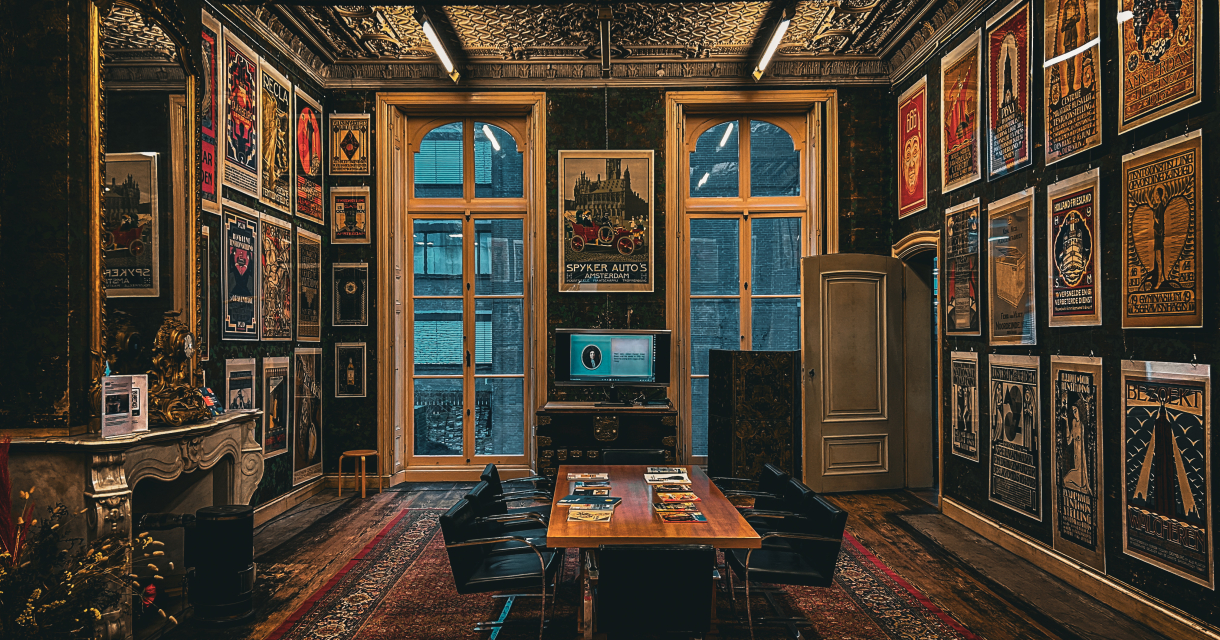
From residence to auction house to museum: that is Design Museum Huis Dedel. A museum in a beautiful 17th-century building on the Prinsegracht in The Hague, where the history of advertising, graphic design and design comes to life!
Design and advertising
All of us deal with advertising on a daily basis. But how often do we consciously look at the designs associated with it? Design says a lot about the time in which it was created and gives the opportunity to approach history from a different perspective.
With a semi-permanent display, Design Museum Dedel will show an overview of 150 years of advertising and design. In addition, be surprised by the various themes of the changing exhibitions such as Russian Avantgarde, Art Deco, the Seventies....
Museum under construction
Not only is the museum evolving as a result of continued restoration, it is also continuing to develop through new insights and opportunities and by establishing and operating partnerships with other similar institutions elsewhere in the world.
Huis Dedel
Design Museum Huis Dedel is named after the building in which it resides and the house takes its name from its builder Willem Dedel.
Construction of Huis Dedel
Willem Willemszoon Dedel, born in 1599 and a lawyer by profession, had a stately mansion built in 1642 for his family on the newly constructed Prinsegracht. By whom he had the house designed is as yet uncertain. But presumably the house was designed by the same architects of the Mauritshuis, namely Jacob van Campen and/or Pieter Post. The classicist facade still bears the family arms of Willem Dedel and his wife.
Willem Dedel did not get to enjoy his house for long. He died in 1650 after which his wife Elisabeth Quartelaar continued to live in the house.
Art enthusiast Jan Hudde Dedel
The first Dedel to have the house altered was Jan Hudde Dedel. He lived in the house from 1733 until his death in 1777. Jan Hudde Dedel is responsible for the eyecatcher of the house: the stucco work in the stairwell. He had this made by Italian craftsmen in Rococo/Lodewijk XV style. The stucco can also be seen in other places in the house. In addition, he had a number of ceiling paintings made by the famous painter Jacob de Wit, which De Wit produced around 1736. A few design drawings have survived and are now in museums. The motifs of those paintings are derived from Greek myhtology and rhyme nicely with the stucco in the stairwell.
When Jan Hudde Dedel died, the house was transferred to his son Abraham Dedel. After his father's death, Abraham did not live there but he kept the house in his possession until his death in 1798. A year after that, house Dedel was bought at public auction by Dr. Antoni Gerard Drijfhout for about 19,000 guilders. With that purchase, the house was out of the Dedel family's possession for good (after 150 years).
Historical wallpaper
The layering of style is further emphasized by the historic wallpaper preserved in several rooms, the oldest dating back to 1799. In fact, this is one of the few interiors in the Netherlands with so much of the original wallpaper still present. With its various patterns, the wallpaper forms a beautiful backdrop for the graphic collection of posters and advertising material.
Ceiling paintings
Ceiling paintings were also common in houses like Huis Dedel at that time. Jacob de Wit was the leading painter in that genre. The value of such a ceiling painting was obvious to anyone and there was a lively trade in it. When moving house, it was not uncommon to take or sell such a ceiling. The ceiling paintings of Huis Dedel were also unfortunately sold, The Rothschild banking family acquired them around 1880. Most were applied in a Palace in Vienna, which did not survive World War II.
Van Stockum's Antiquarian Booksellers
After the house was no longer owned by the Dedel family, it passed through the hands of several families. Until August 11, 1908, when it was sold to J.B.J. Kerling. Kerling established his business in the property, well known as Van Stockum's Antiquariaat. An auction house that operated under different owners at 15 Prinsegracht until 2016 and is now part of the Venduehuis.
Visitor information
Design Museum Huis Dedel is a museum in development. The complete restoration of the 17th century city palace will take years and depends on grants and specialists. Therefore, the museum will open in phases. In the beginning, only the bell floor will be accessible, then the new entrance through the basement, the museum store, the 1st floor and, as a finale, the large attic.
From The Hague Central Station
Streetcars leave every few minutes from The Hague Central Station. If you take the Jan Hendrikstraat exit at the Grote Marktstraat streetcar stop you get off in front of the door of Design Museum Huis Dedel. streetcar 2, 3, 4, 6: get off at the Grote Marktstraat stop. bus 22, 24 or 28: get off at the Centrum stop
From The Hague Hollands Spoor Station
Streetcar 16 - get off at Centrum stop, walk about 7 minutes from there. bus 22; get off at Centrum stop
By bicycle
Then use the guarded bicycle parking facilities at Biesieklette Grote Markt or one of the other parking facilities in The Hague. For more information visit: www.biesieklette.nl

